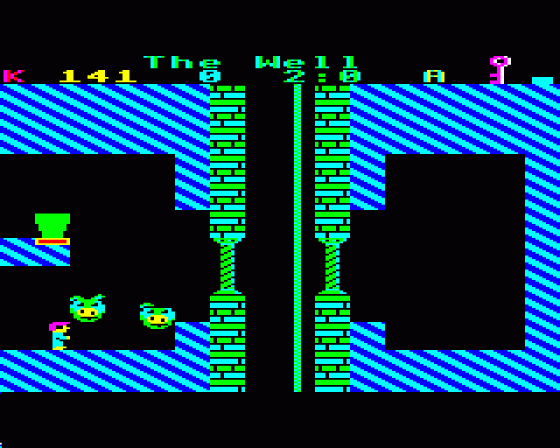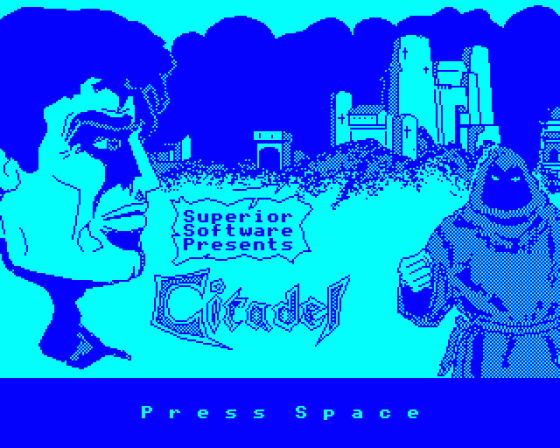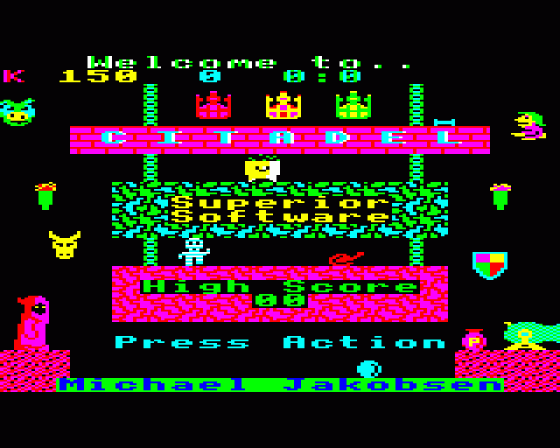
A&B Computing
 1st February 1986
1st February 1986
Categories: Review: Software
Author: Anne Owen
Publisher: Superior
Machine: Acorn Electron
Published in A&B Computing 3.02
Citadel, Citadel, this is Citadel rasps the Superior software speech as the loading screen makes way for the Main Hall screen, the beginning of your journey and regularly returned to in your early forays as you head out into the vast complex of rooms which is the world of Citadel.
Your mission is to thwart an alien invasion by destroying the teleport built by the slaves of Marduk the Dictator. This deserted castle is his base. As you travel out from the Main Hall along passages, through rooms and up fireman's poles, you come across a myriad of objects and creatures, each with different characteristics.
The five crystals have to be collected and taken to the temple on the island. Other objects such as bucket, trampoline and cannonball can be picked up and carried. Flasks are to be collected to restore your energy which drains slowly away, accelerated by contact with a host of nasties, both static and mobile. As in similar games, you need skill to judge the jumps and, with a few exceptions, rooms can be completed without loss of energy. There's a tremendous variety of objects getting in your way. Especially prevalent are pots of burning liquid. It's a matter of figuring out the patterns of movement and picking your moment. If you've played similar games then you'll progress quickly around the game and investigating locations is part of the fun. The screen layout is very helpful for explorers with a room coordinate relative to your start position.

If you run into trouble on any screen and are losing energy fast then the game automatically flies you back to the spot you entered to have another go. A major obstacle on many screens will be the Monk, a beautifully drawn shambling character twice the size of the other sprites. It is often necessary to play cat and mouse with the monks and to lure them into the open where you can disable them by firing a spell (Space Bar or Shift) into their eyes. The monk will always return to its position for the next time you enter that room.
Apart from the castle there's the pyramid, an ocean to traverse, the island and temple. As well as nicely designed sprites, the game features lots of nice touches in sound and graphics, a splash when you jump into the ocean for instance. There are also amusing moments as you dodge starfish and doggy paddle your way to the beach. Citadel is very much a fun game, captivating you through weight of numbers if nothing else.
The programming is beyond criticism. Screen by screen the movement is smooth and flicker-free. Much of the apparent movement is achieved by clever use of flashing colours but bouncing blocks and the monks slide smoothly about. The program actually uses a new screen mode (another?) which gives eight colours in 15K. Other colours are created by shading.

There's no music while playing (stand by for an amazing finale!) but plenty of appropriate sounds. And how do they get all the rooms into memory? The program loads at &400 and takes up virtually all of memory. This is not scrollerama but a more conventional room by room approach excellently implemented.
Nor is the temple the end of matters. The five crystals activate the teleport. You travel to the alien planet, retrieve a bejewelled figurine which, on your return, obliterates the teleport with a field of anti-matter thus averting the invasion! Quite a story.
Having destroyed the teleport you can get your rightful reward and achieve the accolade of Ruler of Citadel by collecting three crowns which have been hidden in secret rooms.
Citadel certainly provides the adventure element as well as the arcade. It overcomes the problems of presenting another arcade adventure with imaginative plot and sheer weight of numbers, of locations, objects and puzzles. It's possible that some seasoned game players will find Citadel, the arcade game, easy, but everyone can enjoy Citadel, the adventure, and will feel the compulsive urge to master this game.
Other Reviews Of Citadel For The Acorn Electron
Citadel (Superior)
Superb Citadel
Citadel (Superior)
A review by James Bibby (Electron User)
Citadel (Superior)
A review by Matthew Fifield (A&B Computing)
Citadel (Superior)
Acres Of Action
Citadel (Superior)
A review



